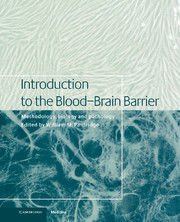Book contents
- Frontmatter
- Contents
- List of contributors
- 1 Blood–brain barrier methodology and biology
- Part I Methodology
- Part II Transport biology
- 18 Biology of the blood–brain glucose transporter
- 19 Glucose transporters in mammalian brain development
- 20 Blood–brain barrier amino acid transport
- 21 P-glycoprotein, a guardian of the brain
- 22 Blood–brain barrier ion transport
- 23 Ion channels in endothelial cells
- 24 Interactions of lipoproteins with the blood–brain barrier
- 25 Fatty acid and lipid intermediate transport
- 26 Blood–brain barrier transport of drugs
- Part III General aspects of CNS transport
- Part IV Signal transduction/biochemical aspects
- Part V Pathophysiology in disease states
- Index
20 - Blood–brain barrier amino acid transport
from Part II - Transport biology
Published online by Cambridge University Press: 10 December 2009
- Frontmatter
- Contents
- List of contributors
- 1 Blood–brain barrier methodology and biology
- Part I Methodology
- Part II Transport biology
- 18 Biology of the blood–brain glucose transporter
- 19 Glucose transporters in mammalian brain development
- 20 Blood–brain barrier amino acid transport
- 21 P-glycoprotein, a guardian of the brain
- 22 Blood–brain barrier ion transport
- 23 Ion channels in endothelial cells
- 24 Interactions of lipoproteins with the blood–brain barrier
- 25 Fatty acid and lipid intermediate transport
- 26 Blood–brain barrier transport of drugs
- Part III General aspects of CNS transport
- Part IV Signal transduction/biochemical aspects
- Part V Pathophysiology in disease states
- Index
Summary
Introduction
Amino acids serve critical roles in brain and are required for normal brain development and function. However, marked differences exist among amino acids, in the roles they serve and metabolic handling within the nervous system.
For example, glutamate, aspartate, glycine, and GABA operate as neurotransmitters in brain and may, in fact, be the predominant neurotransmitters at over 90% of central nervous system synapses (Smith and Cooper, 1992). As a result, they are synthesized locally in neurons and their release and re-uptake are regulated closely to maintain synaptic efficiency. In contrast, most large neutral and basic amino acids, including arginine, lysine, tryptophan, leucine, isoleucine, valine, methionine and phenylalanine, cannot be synthesized in brain, yet are required for brain protein synthesis and as precursors for serotonin (tryptophan), nitric oxide (arginine) and the catecholamines (tyrosine). These ‘essential’ amino acids must be delivered to the brain from the circulation to ensure normal cerebral growth and metabolism.
The handling of amino acids at the bloodbrain barrier reflects this dichotomy. Most dietary ‘nonessential’ small neutral and anionic (acidic) amino acids have very slow rates of uptake into brain, and, in fact, may be shuttled out of brain by active transport (Oldendorf, 1971; Pardridge, 1983; Al-Sarraf et al., 1995).
- Type
- Chapter
- Information
- Introduction to the Blood-Brain BarrierMethodology, Biology and Pathology, pp. 188 - 197Publisher: Cambridge University PressPrint publication year: 1998
- 31
- Cited by



